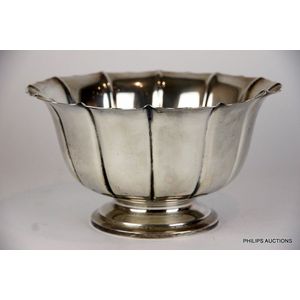Georg Jensen-inspired Sterling Silver Dublin Bowl
You must be a subscriber, and be logged in to view price and dealer details.
Subscribe Now to view actual auction price for this item
When you subscribe, you have the option of setting the currency in which to display prices to $Au, $US, $NZ or Stg.
- Scallop / Shell Motif - The shell motif has been used in furniture and decorative arts for centuries. In ancient Greece and Rome, shells were often used as decorative elements on furniture and in mosaics. The scallop or cockleshell are the most commonly used. During the Renaissance, the shell motif became popular in furniture and architecture, as the ornate decoration was seen as a symbol of wealth and luxury. In the 18th century, the Rococo style of furniture and decorative arts featured an abundance of shell motifs, and it was used by Thomas Chippendale and as a feature on Queen Anne style cabriole legs. In the 19th century, the shell motif was incorporated into Victorian furniture and decorative items, and often a representation of the the conch shell was inlaid into furniture.
- Sterling Silver - Sterling silver is a mixture of 92.5% pure silver and 7.5% of another metal, usually copper. Fine silver is 99.9% pure silver, and is relatively soft and the addition of the very small amount of copper gives the metal enough strength and hardness to be worked into jewellery, decorative and household objects.
This item has been included into following indexes:
Visually similar items

A George III cast sterling silver sugar bowl, 1793 London, makers mark illegible (mis-struck), having scrolling shell style handles. Height 10 cm. Width 20.5 cm, (handle to handle). Weight: 430gms

A silver foliate-rimmed bowl, circa 1900, decorated with birds and flowers, 9 cm high, 15 cm wide

An Edwardian sterling silver deep hexagonal shaped fruit bowl with Art Nouveau pierced gallery border. James dixon & Sons. Weight 544g. Width 23 cm

Israeli silver cup H6 cm approx, 59grams approx
